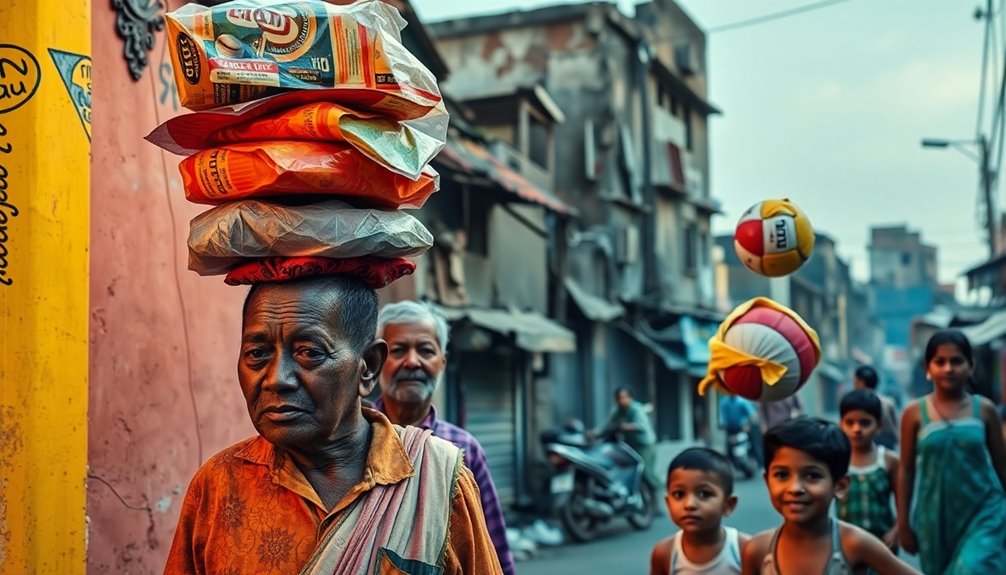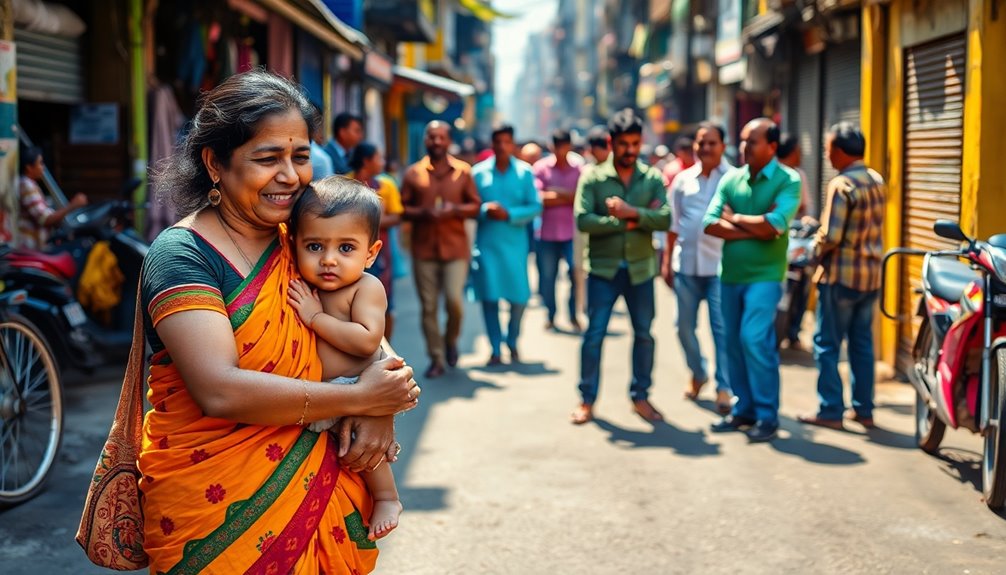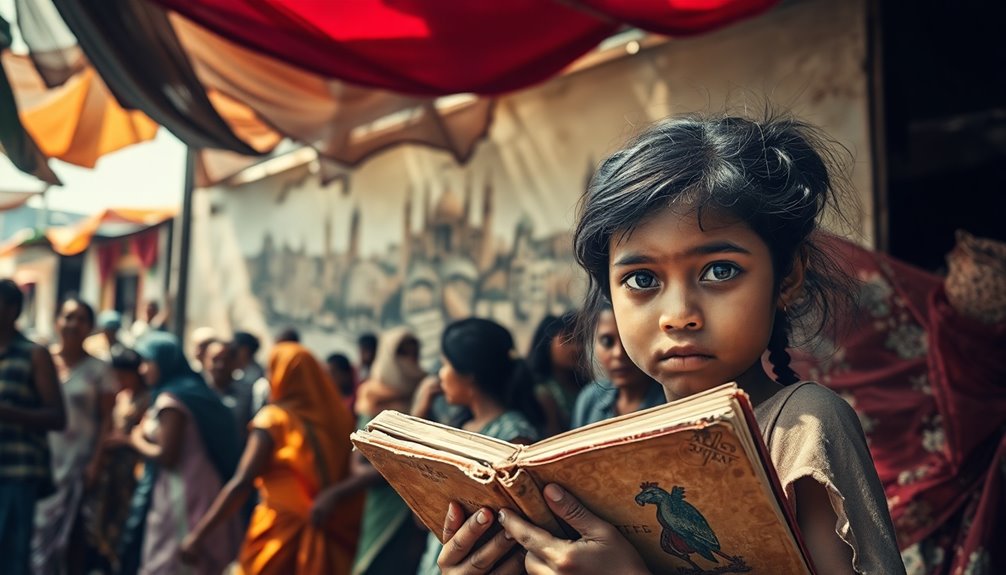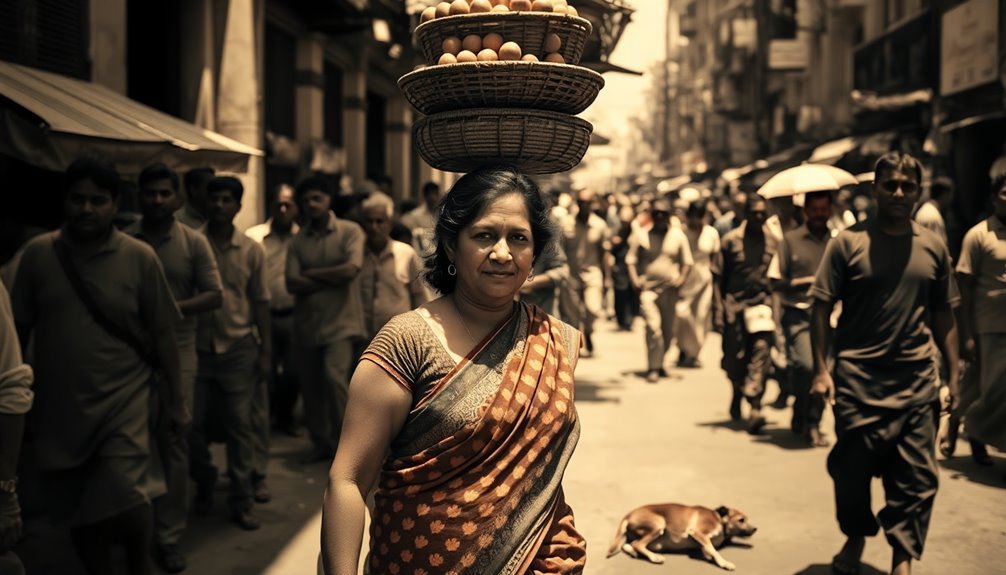In "A Fine Balance," Rohinton Mistry captures life's complexities by intertwining themes of resilience, caste discrimination, and social injustice in 1970s India. You'll see characters like Dina, Ishvar, and Omprakash navigate their intertwined lives amid political turmoil and economic disparities. Humor becomes a lifeline for these characters, reflecting their unyielding spirit. Their shared struggles highlight the fragility of human connections and the importance of community. If you explore further, you'll discover more about their journey and its profound impact.
Overview of A Fine Balance

Rohinton Mistry's "A Fine Balance" paints a vivid picture of life in 1970s India during a time of political upheaval. The novel intricately weaves the lives of four main characters: Dina Dalal, Ishvar Darji, Omprakash Darji, and Maneck Kohlah, revealing their struggles against the backdrop of societal challenges.
Ishvar, a tailor from a marginalized caste, embodies the harsh realities of caste discrimination and poverty. His journey highlights the systemic barriers that define their existence, akin to the systemic oppression faced by Bigger Thomas in Richard Wright's "Native Son." Mistry's portrayal of these struggles resonates with systemic racism narratives found in Ta-Nehisi Coates' work.
Mistry's compelling narrative captures the delicate balance between joy and despair, immersing you in the characters' experiences. Through rich descriptions, you not only witness their trials but also feel the weight of their connections, making the story resonate deeply within you. This exploration of social injustice echoes the themes found in classic literature, such as Dickens' "David Copperfield."
Themes of Resilience and Hope
Life's complexities in *A Fine Balance* reveal not just the struggles faced by the characters but also their remarkable resilience and hope.
Characters like Ishvar and Om endure immense hardships yet endeavor to maintain their dignity, dreaming of a brighter future. Mistry juxtaposes despair with moments of joy, showcasing how they find humor and connection even in dark times. In a similar vein, *The Book Thief* illustrates how characters find resilience amid adversity in the face of overwhelming challenges.
The title symbolizes the fine balance between hope and despair that they navigate daily. Through the bonds formed among Dina, Ishvar, Om, and Maneck, Mistry emphasizes the strength found in community, providing emotional support amid their challenges. This reflects the transformative power of trauma recovery, showing how shared experiences can foster healing.
Ultimately, the novel critiques societal injustices while celebrating the human spirit's ability to persevere and cling to hope against overwhelming odds. Creative expression serves as a vital outlet for the characters, allowing them to process their trauma and navigate their difficult experiences.
Characterization and Relationships

In Mistry's work, you'll see how interconnected lives shape the narrative, revealing the complex power dynamics at play. The characters' relationships evolve, showcasing community resilience in the face of adversity. As they navigate their struggles together, you'll witness the power of empathy and solidarity in overcoming societal barriers. Their journey reflects the importance of collective action in achieving justice and unity against oppressive forces. This emphasis on social injustice resonates with the experiences of marginalized communities, mirroring the struggles depicted in Steinbeck's "The Grapes of Wrath." The characters embody the spirit of resilience that is essential for survival amidst harsh conditions, much like the Joad family's fight against oppression.
Interconnected Lives
Amidst the backdrop of 1975 India, the lives of Dina Dalal, Ishvar Darji, Omprakash Darji, and Maneck Kohlah intertwine to reveal a rich tapestry of social dynamics and shared struggles.
Their interconnected lives showcase the resilience of the human spirit as they confront their individual challenges.
Dina employs Ishvar and Omprakash as tailors, creating a sense of community that thrives despite the harshness of caste discrimination.
Maneck, a student from a wealthier background, further enriches their relationships as they navigate aspirations and societal pressures together.
Through shared meals and growing bonds, the characters transcend their differences, illustrating the profound impact of solidarity across class divides.
Mistry beautifully captures how these connections foster hope and resilience amid adversity.
Power Dynamics
The interconnected lives of Dina, Ishvar, Omprakash, and Maneck reveal a complex web of power dynamics that shape their relationships and experiences.
You see how Ishvar and Omprakash confront systemic oppression as lower-caste Chamaars, struggling against societal barriers.
Dina's fight for independence after her husband's death highlights the challenges faced by women in a patriarchal society, revealing her vulnerabilities while she employs the tailors.
Maneck, caught between his privileged background and his friends' struggles, grapples with identity and societal expectations.
The oppressive presence of Thakur Dharamsi and the manipulative Beggarmaster further illustrate these power dynamics, exploiting the desperate.
Together, their interactions form a microcosm of Indian society, showcasing both the harsh realities and the moments of humanity amid injustice.
Community Resilience
While managing their struggles, the characters in *A Fine Balance* create a tight-knit community that becomes their source of strength.
Dina employs Ishvar and Omprakash, fostering mutual support and shared purpose amidst adversity. Despite their differences, they bond over shared meals, forming a family-like dynamic that emphasizes human connection.
Ishvar and Omprakash's relationship illustrates the community resilience of the Chamaar caste, traversing hardships with loyalty and solidarity against systemic oppression.
Maneck's involvement further highlights their interconnectedness, as he seeks his identity while providing financial support.
Through shared experiences of displacement and loss, the characters deepen their understanding of vulnerabilities, reinforcing the strength of community resilience in a tumultuous society.
Together, they embody the power of connection.
The Impact of Political Turmoil

Political turmoil can dramatically reshape lives, as seen in Rohinton Mistry's portrayal of India's Emergency period from 1975 to 1977.
During this chaotic time, Mistry critiques the government's brutal policies, like forced sterilizations, showcasing the abuse of power and human rights violations. You witness how characters like Ishvar and Omprakash suffer severe consequences due to political decisions, illustrating the harsh realities faced by lower castes within the caste system. Embracing challenges enhances personal growth, as Mistry's characters navigate the oppressive environment imposed by the state. Additionally, the trauma endured by these characters reflects the broader historical context of human rights violations during politically charged times, echoing themes found in other historical narratives.
Their experiences in sterilization camps highlight the socio-economic disparities exacerbated by the political climate. Mistry's narrative serves as a poignant reminder that political turmoil disrupts personal lives and community dynamics, emphasizing the fragile balance between individual aspirations and the overwhelming force of state power. This mirrors the ethical implications of medical research faced by marginalized individuals, underscoring the ongoing struggle against systemic injustices.
Social Commentary on Inequality
In *A Fine Balance*, you see how the caste system still looms large, affecting every aspect of life for characters like Ishvar and Omprakash. Mistry exposes the stark economic disparities that separate them from wealthier individuals, highlighting the unfairness ingrained in society. As you read, it becomes clear that these inequalities shape not only their struggles but also their relationships. The theme of generational poverty resonates throughout the narrative, reflecting the harsh realities faced by marginalized communities. Furthermore, the systemic discrimination faced by these characters mirrors the challenges that many communities of color encounter today in their fight for equity initiatives. In navigating these societal issues, Mistry's characters echo the experiences of those in historical narratives like the challenges faced by women in 18th century England.
Caste System Persistence
Even as society officially outlaws the caste system, its shadows linger in the lives of characters like Ishvar and Omprakash, who grapple with the harsh realities of their Chamaar identity.
Mistry vividly illustrates how systemic oppression shapes their existence, affecting their dignity and dreams.
You'll notice:
- Persistent discrimination in employment opportunities
- Societal prejudice that undermines self-respect
- Exploitative practices by figures like the Beggarmaster
- The brutality of authorities reinforcing caste divisions
Through these narratives, Mistry critiques the complicity of societal structures that perpetuate inequality.
The enduring legacy of the caste system manifests in the characters' struggles for upward mobility, reminding us that breaking free from these deep-rooted hierarchies remains an uphill battle.
Economic Disparities Illustrated
Economic disparity serves as a powerful lens through which Rohinton Mistry examines social inequality in *A Fine Balance*.
You witness the stark contrast between Ishvar and Om, members of the Chamaar caste, and the middle-class struggles of Dina and Maneck. Mistry highlights their forced labor on government projects, illustrating the exploitation rooted in economic disparities.
The demolition of Ishvar and Om's slum dwelling by authorities emphasizes the fragility of their socioeconomic status. You see how the caste system perpetuates these inequalities, limiting social mobility.
Yet, through their relationships, Mistry shows the strength of community in the face of hardship. This solidarity becomes a crucial response to economic inequalities, fostering resilience among those marginalized by society.
The Role of Humor Amidst Tragedy
While life often presents us with overwhelming challenges, humor emerges as an essential lifeline for Rohinton Mistry's characters in *A Fine Balance*. You'll notice how they use humor to cope with dire circumstances, showcasing their resilience.
In the face of tragedy, laughter often highlights the absurdity of their situations, creating a poignant interplay between comedy and despair.
- Witty dialogue brings lightness to heavy themes
- Situational irony emphasizes the characters' struggles
- Shared laughter fosters deeper connections among them
- Humor reflects the human spirit's capacity for joy
Mistry's ability to infuse humor into serious themes allows you to see that even in the bleakest moments, there's room for joy amidst life's complexities.
The Significance of Coincidences
In *A Fine Balance*, you'll notice how coincidences intricately link the characters, creating a tapestry of fate that shapes their lives.
These chance encounters heighten narrative tension and offer moments of release, emphasizing the unpredictability of their existence.
Through these connections, Mistry showcases both the randomness of life and the resilience found in human relationships.
Coincidences in Character Connections
Coincidences play a significant role in shaping character connections in Rohinton Mistry's "A Fine Balance," where the intertwining lives of Ishvar, Omprakash, Dina, and Maneck illustrate the unpredictable nature of fate. These chance encounters reflect the broader societal context of 1970s India, emphasizing shared human experiences amidst adversity.
Consider these key points:
- Minor characters' coincidences highlight interconnectedness.
- Randomness of fate influences character development.
- Coincidences enhance the complexity of relationships.
- The narrative invites you to embrace life's unpredictability.
While some readers may question the plausibility of these coincidences, they're essential to understanding the characters' journeys.
Mistry effectively shows how these serendipitous moments can alter lives, balancing hope and despair through their intricate connections.
Narrative Tension and Release
As you explore Rohinton Mistry's *A Fine Balance*, you'll notice how narrative tension and release hinge on the unexpected coincidences that shape the characters' lives. These coincidences interconnect their fates, illustrating how external events and systemic forces influence their struggles.
While some critique this reliance on chance, it reinforces the unpredictability of life in a politically turbulent society. Mistry's characters often find themselves in serendipitous moments, emphasizing the fragility of their hopes amidst despair.
Furthermore, these coincidences highlight broader societal issues, such as caste discrimination and governmental oppression, suggesting that personal battles mirror larger conflicts. By embracing these elements, you witness how chance encounters can considerably alter destinies, enriching the narrative's themes of interconnectedness and complexity.
Exploration of Caste and Class
While steering through the intricate tapestry of Indian society, Rohinton Mistry's *A Fine Balance* reveals the deep-seated issues of caste and class that shape the lives of its characters.
You'll witness how the caste system profoundly impacts Ishvar and Omprakash, who endure discrimination and violence. The novel contrasts their struggles with those of wealthier characters like Maneck, emphasizing complex class dynamics.
Key themes include:
- The persistence of the caste system despite its illegality
- The stark survival challenges faced by lower-class individuals
- The tension and solidarity in relationships across different backgrounds
- Dina's quest for independence amid patriarchal and class-driven pressures
Mistry brilliantly critiques how social hierarchies dictate fate and limit opportunities in this harsh reality.
The Journey of Personal Growth
Mistry's exploration of caste and class intricately intertwines with the characters' journeys of personal growth, revealing how adversity shapes them.
Dina transforms from a dependent widow to an independent businesswoman, asserting her autonomy against societal expectations.
Ishvar and Omprakash evolve from rural tailors to city dwellers, showcasing their resilience as they adapt to urban life while facing numerous challenges.
Maneck's quest for identity highlights his struggle against societal pressures, emphasizing the search for meaning in despair.
The bonds formed among these four characters illustrate how shared experiences and mutual support foster personal growth and resilience.
Their traumatic experiences, including forced sterilization, catalyze their transformations, allowing them to confront vulnerabilities and discover strength in their relationships.
Vivid Imagery of Life in India
Life in India bursts with vivid imagery that draws readers into its sensory richness. Rohinton Mistry's writing immerses you in the contrasting landscapes of urban chaos and rural hardship, highlighting socio-economic disparities. You can almost feel the oppressive heat and smell the diverse aromas that define his characters' lives.
- The bustling streets filled with vendors and chatter
- Slums that reveal the harsh realities of survival
- The vibrant colors of local markets
- Quiet moments that capture the resilience of the human spirit
Through these descriptions, Mistry intricately portrays the struggles of his characters, making their experiences palpable. His metaphorical language, like life as a game of chess, adds depth to their complex journeys, inviting you to reflect on their resilience amidst adversity.
The Fragility of Human Connections
How do fragile human connections shape our experiences in the tumult of life? In *A Fine Balance*, you see how Dina, Ishvar, Om, and Maneck forge deep bonds amid adversity, illustrating the power of shared experiences.
Their familial connection offers solace as they navigate the harsh realities of politically turbulent India. Yet, the fragility of these human connections is constantly tested by poverty, societal pressures, and government oppression.
Moments of humor and care emerge, reminding you that love and empathy can thrive even in bleak circumstances.
Ultimately, Mistry highlights that while these relationships may be delicate, they're essential for resilience and survival, emphasizing that it's through our connections that we find strength in life's complexities.
Lessons on Survival and Community
Amid the fragility of human connections, lessons on survival and community emerge vividly in *A Fine Balance*. Rohinton Mistry illustrates how Ishvar and Omprakash adapt to urban life, highlighting their resilience.
The bond between Dina, Ishvar, and Omprakash emphasizes the importance of community support in facing adversity.
Key lessons include:
- Survival hinges on mutual reliance and shared purpose.
- Community creates familial bonds, even amidst struggles.
- Shared meals symbolize strength and collective joy.
- Solidarity and compassion are essential to overcoming systemic challenges.
Through these experiences, Mistry underscores that it's not just about surviving; it's about thriving together, fostering connections that provide hope and resilience against life's harsh realities.
Reflections on the Human Spirit
Resilience shines brightly in Rohinton Mistry's *A Fine Balance*, where the human spirit navigates the tumultuous waters of adversity and social injustice.
Through the intertwined lives of four characters, you witness their unwavering hope and strength amidst overwhelming challenges. The title captures the delicate balance between despair and joy, as they find fleeting moments of happiness in harsh realities.
Mistry vividly portrays the struggles of lower-caste individuals, emphasizing their ability to endure and adapt despite systemic oppression.
Humor and camaraderie emerge as essential lifelines, showcasing how human connections help overcome life's trials. In the darkest times, you see love, friendship, and the quest for dignity, illustrating that the human spirit truly persists against all odds.
Conclusion
In "A Fine Balance," Rohinton Mistry intricately weaves the struggles and triumphs of his characters, reminding you that resilience often shines brightest amid adversity. Did you know that over 364 million people in India live in extreme poverty? This stark reality amplifies the novel's powerful social commentary on inequality and human connection. As you turn the last page, you can't help but reflect on the enduring spirit of community and the lessons of survival that resonate beyond the text.



